For those of you who have been regular readers of The Paranormalist, you’re probably aware that I’ve regularly covered the work of cryptozoologist Adam Davies. Adam and his team of fellow cryptid researchers have traveled to many far-flung corners of the globe in search in order to investigate reports of a wide variety of heretofore unclassified and undiscovered species of animal. Of the many creatures that Adam has sought, his most promising and compelling evidence has been found in the rainforests of Sumatra while searching for that country’s legendary hominoid, the Orang Pendek.

The Orang Pendek (Indonesian for “short man”) is reputed to be a bipedal species of ape or proto-humanoid that stands roughly one meter tall and is generally reported as being covered in an orange fur or hair, similar to the Orangutan. However, the Orang Pendek is described as being distinctly different from the Orangutan in that it is more humanoid in appearance and walks in a completely upright, human-like posture.
In a number of previous visits to Sumatra, Adam and his fellow researchers have come away with clear plaster castes of the creature’s footprints, hair samples, and even an eyewitness sighting by team member Dave Archer. Most recently, DNA was from a hair sample and analyzed by an independent laboratory, the results of which indicated that the hair sample did not come from a known species of animal.
Because of the volume and quality of the evidence gathered thus far, Adam is once again setting out for the dense forests of Sumatra this coming September 2011. In association with the Center for Fortean Zoology, he will be leading the team which will consist of fellow researchers Dr. Chris Clark, Richard Freeman, Dave Archer, Jon McGowan, Lisa Dowley, Andrew Sanderson, and Rebecca Lang, and Mike Williams from CFZ Australia.
Another Eyewitness Account
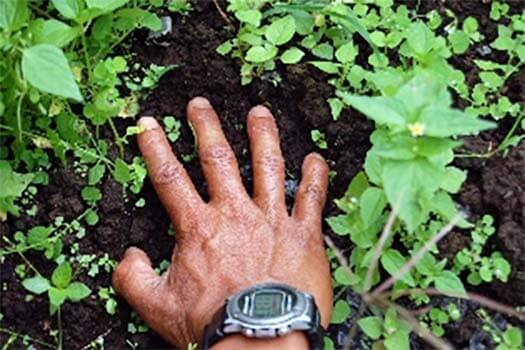
Adam Davies recently passed along to me some interesting news that he received concerning an eyewitness account from a Sumatran native. Interviewers Tim de Frel and Martijn van Opijnen, both of Den Haag, Holland, interviewed a Sumatran man named Pak Man, age 54 on the 22nd of March 2010. Pak is a resident of Pelompek in the Jamba Province of Sumatra, and claims to have seen the Orang Pendek on more than one occasion.
The first part of the interview was done in the morning at the house of Sahar Dimus, also a resident of Pelompek in Jambi Province. Sahar functioned as the interpreter. Here is the information gathered from the interview:
The first part of the interview was done in the morning at the house of Sahar Dimus, also a resident of Pelompek in Jambi Province. Sahar functioned as the interpreter. Here is the information gathered from the interview:
The respondent gave an account of a sighting in his shed on his farm, north of Pelompek along the highway. The sighting occurred some ten days previous at around ten o’clock at night.
The respondent was sleeping in his bunk when he heard something breaking into his shed. At first, he thought it was a bear or a tapir, but when he looked through the planks of his bunk, he saw a figure sitting next to a pole, eating from some sugarcane that was in a plastic bag. He could see the animal very well because a burning candle was at the pole just above the animal. It was about one meter tall.
The animal was covered with short hair, a bit longer in the neck. The features that struck the respondent the most was the large, round torso, a very large stomach, the short legs and the long arms. The animal had a rounded head, no neck, bright blue eyes, long eyebrows, two holes instead of a nose, a big non protruding mouth with thin purple lips and its ears sticking out. No genitals or breast were visible.
The animal had long fingers, with its thumbs at the side of the hand. It used its hands in the same fashion that humans do. It ate the pieces of sugarcane as humans eat corn. No tail was visible. On each foot, it had four toes and one very large one sticking out at the side. The general impression the animal gave was of great strength. The respondent was very afraid and stayed quiet for about ten minutes. He immediately knew that it was Orang Pendek, because of the many stories he had heard in the past, some told by his grandfather. He was certain it was not an Orangutan because he had seen one in the zoo of Bukittingi. It was also not a monkey. He later heard that four other people saw a similar animal in the same week.
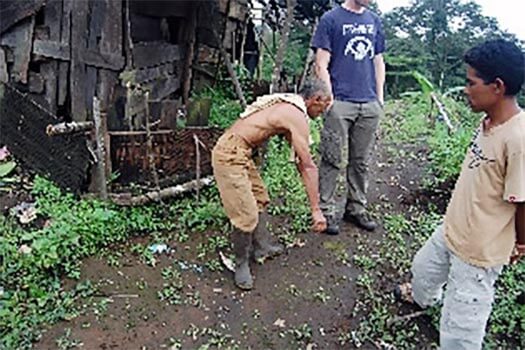
After ten minutes the respondent decided he had seen enough and kicked at one of the planks of his bunk. The animal then walked the to side of the shed and tore away a piece of the wall and walked away. The respondent said the animal walked bent over a bit, its feet sticking to the sides and its arms hanging in front of its body. It walked with short steps and slowly. Respondent then grabbed a spear and followed the animal outside. There it vanished in the dark.
After ten minutes the respondent decided he had seen enough and kicked at one of the planks of his bunk. The animal then walked the to side of the shed and tore away a piece of the wall and walked away. The respondent said the animal walked bent over a bit, its feet sticking to the sides and its arms hanging in front of its body. It walked with short steps and slowly. Respondent then grabbed a spear and followed the animal outside. There it vanished in the dark.
The respondent was then showed some pictures in a book about animals. When showed a picture of an Orangutan, he was certain this was not his animal. A picture of a gorilla and a chimpanzee were much more similar to what he had seen.
The second part of the interview was done on the same day, in the shed of the respondent. The shed is a 45-minute uphill walk from the highway north of Pelompek. It took 30 minutes by motorbikes to reach the location. The area is scattered with a small plot and little sheds. The plot of the respondent was located a mile from the edge of the forest. The shed consists of two spaces, one with a mud floor and a small bunk elevated from the floor. The only way in is by a door at the side. There are a couple of small windows without glass.
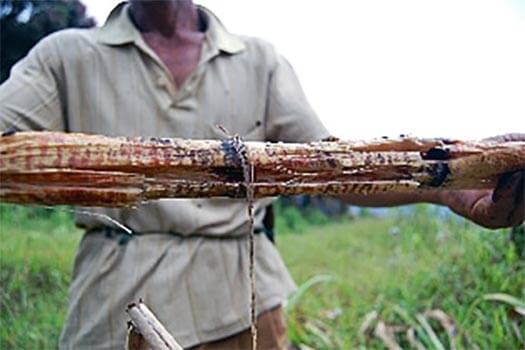
The respondent was asked to tell the story again, and some details were added. For instance, the animal had light, almost white hair around its eyes. The pupils were bright blue. The hair on its body had a light violet grey color. When he scared the animal, it made a sound like a loud cough. Otherwise it was silent. The respondent thought the animal was too heavy to climb trees.
The respondent and mister Dimus were certain that the animal was after sugar, because most of the fruit trees in the forest at that time bear no fruit. The animal also eat Lolo, which is a type of radish with long red fruits. It also tasts like radish. Lolo was present in the area. Just outside the shed, where the earth was loose, a footprint was faintly visible. It looked like the print of a human hand and was of the same size. Because it had rained the previous days, the outline was very vague. The big toe which the respondent had mentioned, didn’t stand out in the print. It looked more like a thumb.
When going back to the road some large pieces of sugarcane were found, which were broken off from the stem. It looked like they were ripped open by teeth and then sucked at. According to the respondent that was the work of Orang Pendek. As the pieces may have been there for days in the rain, and no plastic bags were available, it was decided to leave the pieces where they were found.
Further Scientific Corroboration
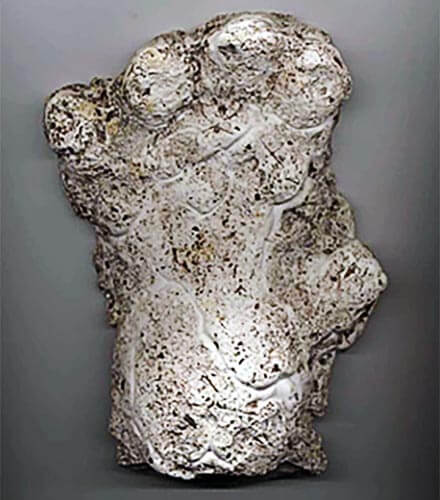
Adam also forwarded me a quote by Dr. Jeffrey Meldrum, Associate Professor of Anatomy and Anthropology, and Adjunct Associate Professor of the Department of Anthropology at Idaho State University. In a recent conversation concerning the plaster caste of a footprint taken in Sumatra by Adam Davies and Andrew Sanderson during their 2001 expedition, Dr. Meldrum had this to say:
“The cast, if accurate, seems most likely to represent a primate appendage of some kind — flat footed, five digit, divergent medial digit — features not combined in other common wildlife tracks. If the cast represents a primate footprint, the very short heel, indicated by the position of the presumed hallux (medial toe) bears some resemblance to that of an orangutan foot, which boasts a remarkably short calcaneal process. However, this feature is combined with short thick digits in the cast in question, unlike the remarkable long lateral digits and shortened hallux of the living orangutan foot. It seems an unusual combination of traits in a terrestrial biped, which the orang pendek is reported to be. Alternately, the cast might be that of a handprint, in which case the proximal position of the medial digit, the thumb, would be more appropriate.”
Dr. Jeffrey Meldrum’s name will likely be familiar to anyone who has even a passing interest in the subject of unknown/undiscovered hominoids. He is one of the few Ph.D.-level scientists to take seriously the possibility of the existence of Bigfoot and other unclassified species of bipedal apes. Dr. Meldrum holds a Ph.D. in anatomical sciences, with an emphasis in biological anthropology. Dr. Meldrum accompanied Adam Davies in 2008 on an expedition to China in search of the legendary Yeren, an apelike creature described by the natives of the countries mountainous regions.
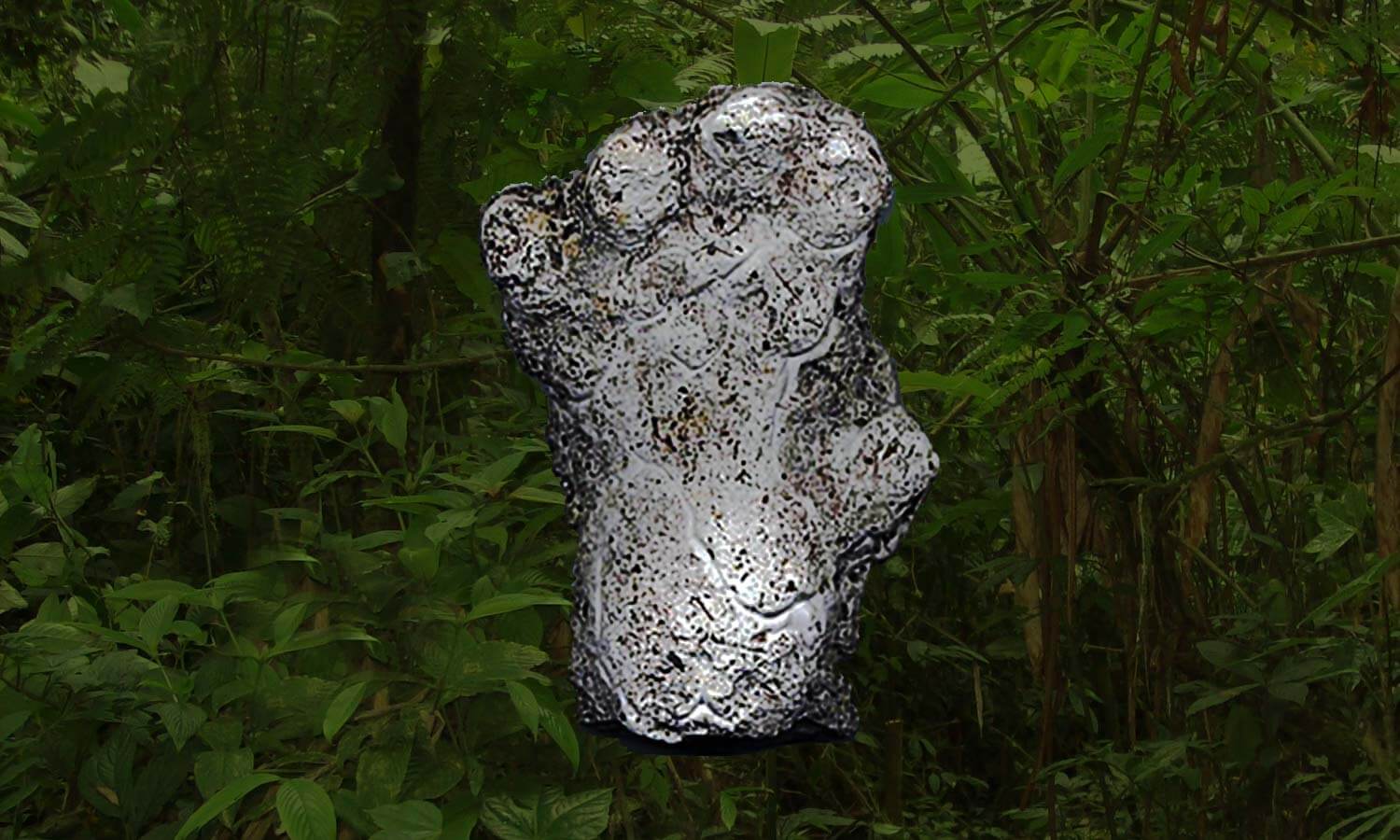
Great post John! I look forward to the forthcoming expedition.
I look forward to hearing all about it, Adam!
Very exciting. Did the team member eyewitness produce a sketch of what she saw, or was the sighting too distant or brief to create an accurate likeness? It certainly appears to be a very close relative to the Orang utan, which makes sense. The rounded face, big belly, two holes where the nose should be – all traits of an Orang utan. Maybe some small group of Orangs somehow have evolved or branched off , if that’s possible.
Hi James – I passed off your question to Adam. I’m sure he can answer you.
When Dave Archer saw the Orang-Pendek , he did sketch it for us at the time.Again, he said the creature was closer in build to a chimpanzee than an Orang.This was of course, before we knew of this report, so it makes it even more interesting. I have mailed Tim to to comment here, if he is around, on his own report.
I have just had an email off Tim, and the witness also described the creature as having `a huge torso` .This is no doubt consitent with the creature being large framed,in proportion to its size.
the man interviewed in his shed has been interviewed another time on this film
https://www.putlocker.com/file/2Y3Y21CPNDK4C8CO#
Orang pandek is very interesting i propose a minimum of 500 trap cameras with infra red capabilitys, as its likeley that orand pandek moves around at night to avoid being seen.
Theres also a possibility of nest or caves/hammoks in the cannopy sleeping at night, as we and some primates do. orang pandek has a bulky upper half for a reason, to climb and to rip open strong stalks, maybe kill small prey it may be eating protien if it is very strong like a chimpanzee
Jamie
I think you meant blues irises?
Greetings,
Apparently the Orang Pendek can be a solitary creature and might have needed to be solitary to have survived so long. While I am not a primate expert I am an experienced tracker and hunter. I’ve given up the latter as hunting is not really a sport as I now prefer to save animals rather than destroy.
This animal may likely sleep in trees even though it is bipedal as it is known to climb them. They may however use more natural areas, rock outcrops, laid over stumps or trees. It appears to be a forest scavenger with a wide variety of foods available. Forest scavengers are nomadic to the point they follow their best food sources even coming into farming communities to meet their needs.
It seems they might also have a group or family system that forage separately. One of the biggest problems I have here is the lack of any scat collected from the species. Has anyone found any? Look high for nests and look below for scat. I wish you all the best in your search. I do wish I could come help.
Sincerely,
David
ODE TO MULTIREGIONAL HUMAN EVOLUTION: There was a crooked man who walked a crooked path of Darwin’s Evolution. As science it is new,and facts there are but few well seasoned with confusion. From lowly shrews-insectivores it seems the primates came. The lemuroids & tasieroids have very little fame. The monkeys are much better known from New World & from Old. Gorilla,Orang,Chimp & Gibbon are Man-like we are told. From apes to man the gap is wide – for a long time left apart, Till small Australopithecus was found by Raymond Dart.How long have they been on the scenes?Those cute Australopithecens? How & where they reached each haunt? Perhaps they started in Levant?? From there through warm Eurasian band & southward through all African land. As they traveled they would find related types of ape-man kind. Hominids of many strange shapes crossed with Bonobos & other such apes. Gorillas,Chimps & Bonobos did their forest thing, while bipedal relatives had their naked fling. Like Timber Wolf of northern snow has no qualms but wants to know the carnal charms of dingo Sheila,or jackal bitch or cute Akita. Like all Canines on this Earth our forebears – bred – ‘nd gave birth,left their genes with all uncouth anywhere they’d find some mirth. As long as genes of Human-kind meshed as still ALL Doggie-kind DNA would ebb & flow & recombine towards high & low.
Thus we see on LINE OF WALLACE Australopithecus on Isle of Flores – some 13,000 years ago — maybe later- the Dutch would know. Australopithecus of LATTER-DAY on FLORES Island I would say – is better way to name that type – Brainette for HOMO is UNripe! Most would die but some survived. Some would kill and THUS survived. Settled types and new-commers produced better survivors. North America HAD primates in days of yore. South America HAS monkeys NOW from shore to shore. Pliopithecus & Dryopithecus of Europe’s past were HOMINIDS TOO so not so fast! As buzzword it may be all th’ rage but OUT OF EVERYWHEREICA can upstage – The paradigm we had learnt to take may be nothing but a fake. Petr Jandacek see http://www.jandacek.com